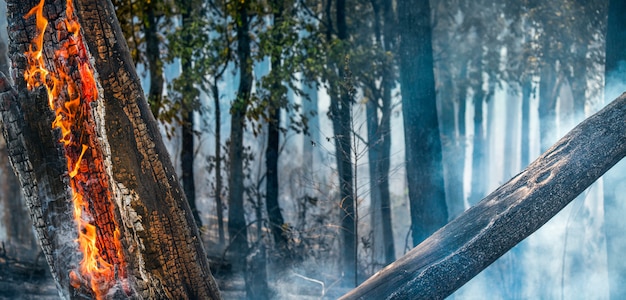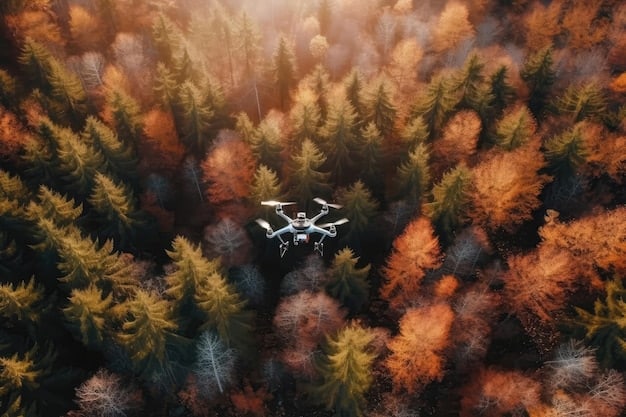Wildfire Prevention: Science-Backed Strategies for US Forests in 2025

Protecting US forests from wildfires in 2025 requires a science-driven approach, focusing on proactive land management, advanced detection technologies, and community engagement strategies to mitigate risks and enhance resilience.
Protecting our nation’s forests from devastating wildfires is a growing concern. The urgency to understand and implement effective prevention strategies has never been greater. This article delves into the science behind wildfire prevention: 3 key strategies for protecting US forests in 2025, offering insights into how proactive measures and innovative technologies can safeguard these vital ecosystems.
Understanding Wildfire Science: Predicting and Preventing Disaster
Wildfires are a natural part of many ecosystems, but their increasing frequency and intensity pose a significant threat to our forests and communities. Understanding the underlying science is crucial for developing effective prevention strategies. This section examines the factors that contribute to wildfire behavior and explores how predictive models can help us mitigate the risk.
The Fire Triangle: Fuel, Heat, and Oxygen
The fire triangle illustrates the three essential elements needed for a fire to ignite and spread: fuel, heat, and oxygen. Removing or managing any of these elements can significantly reduce the likelihood of a wildfire. In the context of forest management, fuel reduction is a primary focus.
- Fuel Management: Reducing the amount of flammable material, such as dead trees, dry brush, and leaf litter, can limit the intensity and spread of wildfires.
- Heat Source Mitigation: Addressing potential ignition sources, such as unattended campfires, equipment sparks, and lightning strikes, is critical for preventing wildfires.
- Environmental Factors: Understanding how weather conditions like temperature, humidity, and wind influence fire behavior is essential for predicting and managing wildfire risk.
By understanding and addressing each component of the fire triangle, we can develop more effective strategies for wildfire prevention and control.
Predictive models, driven by weather data, fuel conditions, and historical fire patterns, play a crucial role in identifying high-risk areas and allocating resources effectively. These models help fire managers anticipate potential outbreaks and implement proactive measures, such as prescribed burns and targeted fuel reduction efforts, to minimize the impact of wildfires.
Proactive Land Management: Reducing Fuel Loads and Creating Firebreaks
One of the most effective strategies for wildfire prevention is proactive land management. By reducing fuel loads and creating firebreaks, we can limit the spread of wildfires and protect valuable resources. This section explores various land management techniques aimed at minimizing wildfire risk.

Prescribed Burns: A Controlled Approach to Fuel Reduction
Prescribed burns, also known as controlled burns, involve intentionally setting fire to vegetation under specific weather conditions to reduce fuel loads and promote ecosystem health. These burns are carefully planned and executed by trained professionals to minimize the risk of uncontrolled wildfires.
Creating firebreaks involves clearing vegetation in strategic areas to create barriers that slow or stop the spread of wildfires. These firebreaks can be natural features, such as rivers and rock outcroppings, or human-made structures, such as roads and cleared strips of land.
Thinning and Selective Logging: Removing Excess Vegetation
- Strategic Placement: Firebreaks are most effective when strategically placed to protect communities, critical infrastructure, and high-value resources.
- Maintenance: Regular maintenance is essential to ensure that firebreaks remain effective over time. This includes clearing vegetation and removing flammable materials.
- Integration with Natural Features: Incorporating natural features into firebreak design can enhance their effectiveness and minimize environmental impact.
Land management techniques like forest thinning will serve to create healthier, more resilient forests. Regular removal of smaller trees reduces competition for resources, making the stand more drought resistant. These measures can significantly reduce the risk of catastrophic wildfires in the long term.
Proactive land management is a critical component of wildfire prevention. By reducing fuel loads and creating firebreaks, we can limit the spread of wildfires and protect our forests and communities.
Advanced Detection Technologies: Early Warning Systems for Rapid Response
Early detection is crucial for effective wildfire response. Advanced detection technologies, such as satellite monitoring, drone surveillance, and sensor networks, are revolutionizing our ability to identify and respond to wildfires in their early stages. This section examines the role of these technologies in enhancing wildfire detection capabilities.
Satellite Monitoring: A Comprehensive View from Above
Satellites equipped with infrared sensors can detect heat signatures associated with wildfires, even in remote areas. This technology provides a comprehensive view of the landscape, allowing fire managers to identify potential outbreaks and track the spread of existing fires.
Drones equipped with high-resolution cameras and thermal imaging sensors can provide real-time information about wildfire behavior. These drones can be deployed quickly to assess the situation on the ground and guide firefighting efforts. They are also useful as mobile hot spot detectors.
Sensor Networks: On-the-Ground Monitoring of Environmental Conditions
- Improved Accuracy: Sensor networks provide highly accurate data on temperature, humidity, wind speed, and fuel moisture, allowing for more precise wildfire risk assessments.
- Real-Time Monitoring: These sensors transmit data in real-time, providing fire managers with up-to-date information about environmental conditions and potential wildfire threats.
- Enhanced Predictive Capabilities: Data from sensor networks can be integrated into predictive models to improve the accuracy of wildfire risk forecasts.

Advanced detection technologies are transforming wildfire management. By providing early warning of potential outbreaks and real-time information about fire behavior, these technologies are helping firefighters respond more effectively and protect our forests and communities.
These networks of sensors, strategically placed throughout forested areas, will be critical in future wildfire prevention efforts. The internet-of-things tech will monitor environmental conditions like heat, humidity, and airborne particulate matter (smoke), providing early warnings of potential fire outbreaks. This real-time data is fed into predictive models and alerts local fire departments, providing crucial time for early response interventions.
Community Engagement and Education
While science and technology play essential roles, community involvement is also vital in wildfire prevention. Educating the public helps reduce human-caused fires. Understanding the dangers involved equips community members with preventive skills to assist.
Educational Programs
Workshops and community meetings serve as platforms for education. Participants learn about fire safety, local resources, and methods for preventing wildfires. The programs feature both the most current strategies and technology used in fire prevention.
Providing resources also enables individuals to defend their houses against fire damage. This includes advice and hands-on instruction with defensible space, which involves clearing vegetation in a 100-foot radius around your house.
Communication Strategies
- Social Media Outreach : Campaigns on Facebook, Twitter, and Instagram are a cost-effective method for connecting with wide audiences. These platforms can publish urgent warning, safety tips, and local prevention drives.
- Direct Outreach : Targeting specific at-risk populations helps in providing specialized teaching. For instance, there might be different methods of teaching children and adults to build backyard fire pits safely.
- Partnerships : Collaborating can greatly increase the efficiency of wildfire prevention initiatives, with local NGOs, fire departments, and educational institutions.
Through educating people and motivating involvement, preventative fire safety can be created through a strong foundation that enables communities to confront fire issues. This approach relies on collective responsibility and knowledge, so that both inhabitants and visitors embrace practices that protect lives and natural ecosystems.
Policy and Funding
Effective wildfire prevention requires a robust framework of supporting policies and sufficient financial resources. The governments at both the state and federal levels, as well as local agencies, are crucial in constructing laws and regulations that boost the effectiveness of wildfire prevention. Furthermore, committed financing is essential to the application of preventive actions and the progression of studies.
Governmental Strategies
The governments can prioritize laws regarding land use to make sure that the developments reduce fire hazards and respect the preservation zones, which help maintain the natural firebreaks. To promote sustainable forestry practices, incentives can be developed to aid people in following practices that also reduce burning fuel.
The government will have several programs to assist local fire departments with technology and training. It will also fund campaigns to educate people regarding fire prevention, with a focus on the particular dangers and best behavior appropriate to each locale.
Financial Commitments By Sector
- Federal Funding : The US Forest Service and the Department of Interior often offer grants for prevention activities. Resources should be used for prevention actions and improving technologies.
- Private Sector Investments : Investments from the private sector would go to technology companies that create new warning systems, and sustainable forest management businesses that implement environmental methods.
- Community-Based Initiatives : Communities can obtain assistance by forming partnerships with neighborhood groups to boost preparedness and fire management, thereby fostering a culture of prevention at the local level.
Efficient financing and supportive policies are essential for encouraging cooperative participation between local groups, government departments, and private parties. This can lead to the growth of preventive procedures and ensure that forests remain secure for future generations. A strong and sustainable strategy will emerge from the coordination of efforts.
Future Innovations in Wildfire Prevention
Advancement in engineering and study offers hope for a more powerful and efficient method of preventing wildfires. The development of the area is not only promising, but also essential to protecting our forests during challenging environmental times.
Technological Innovations
The innovations in data analytics and artificial intelligence are enhancing our ability to predict and analyze fire behavior. Advanced algorithms and sensors can offer real-time data about environmental risks, which makes it possible to get ready and act quickly.
- Advanced Robotics: Drones and robots can monitor remotely and can manage activities considered too risky for human firefighters.
- Material Sciences: The creation of fire-resistant substances for dwellings in high-risk areas may considerably decrease the damage produced by wildfires.
- Biotechnology: Studies into how plant life that is naturally fire-resistant can assist in growing trees and vegetation that limit the spread of fire.
Through ongoing finance and assistance of those improvements, people may look forward to considerable improvement in how effective wildfire are prevented. It is very important to take on such modern strategies if their forests are to remain safe.
| Key Point | Brief Description |
|---|---|
| 🔥 Land Management | Reduces wildfire fuel through burns and thinning. |
| 🛰️ Detection Tech | Uses satellites and sensors for early fire detection. |
| 🧑🤝🧑 Community Action | Educates the public to prevent human-caused fires. |
| 🏛️ Policy & Funding | Ensures resources for prevention and research efforts. |
Frequently Asked Questions (FAQ)
▼
Wildfires are ignited by both natural events such as lightning and human activities. Unattended campfires, discarded cigarettes, and equipment malfunctions are significant human-caused factors.
▼
Prescribed burns reduce the amount of available fuel (dry leaves, dead trees) that can feed a wildfire. This controlled burning helps prevent larger, more destructive wildfires.
▼
Advanced technologies for early wildfire detection include satellite monitoring (using infrared sensors), drone surveillance, and sensor networks on the ground that monitor environmental conditions.
▼
Communities can help by participating in educational programs, maintaining defensible space around homes, and reporting suspicious activities. Awareness and responsible behavior are key to prevention.
▼
Government provides funding, sets policies for land management, and supports research and development of new technologies. They also coordinate responses during wildfire events.
Conclusion
The science behind wildfire prevention relies on a combination of proactive land management, advanced detection technologies, community engagement, and supportive policies. By understanding the factors that contribute to wildfire behavior and implementing targeted prevention strategies, we can protect our forests and communities from the devastating impacts of wildfires.





